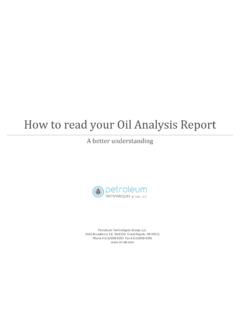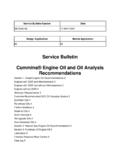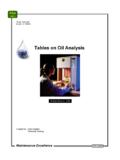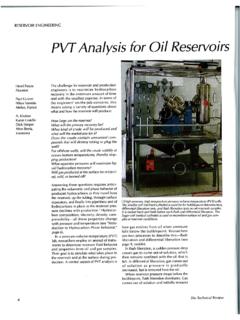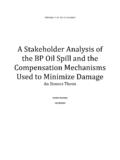Transcription of Exploitative Labor Practices in the Global Palm Oil …
1 Exploitative Labor Practices in the Global Palm Oil Industry Prepared by Accenture for Humanity United 2 Introduction Palm oil is the world s most popular vegetable oil, accounting for 34 percent of Global vegetable oil consumption. It is found in one of two products sold in Western supermarkets, ranging from Dove soap to Ben & Jerry s ice cream. Labeling regulations in the United States permit palm oil to be listed simply as vegetable oil, leaving many consumers unaware of its nearly ubiquitous presence in everyday products. The opposite is true in Asia and other developing regions, where consumers have long used palm oil as a primary source of cooking oil. Regardless of whether people consume knowingly or not, over the past 40 years, Global consumption of palm oil has increased at a rate of percent.
2 The vast majority of the world s palm oil supply, nearly 85 percent, is grown in Indonesia and Malaysia. The palm oil industry is very significant to the economies of both countries. It is the largest agricultural export from both countries and in 2010 accounted for percent of Malaysia s GDP and percent of Indonesia s. The palm oil industry also an important employer in both countries, employing as many as million workers across Malaysia and Indonesia. However, to meet the growing Global demand for cheaply produced palm oil, some producers are relying on forced Labor and other forms of modern slavery. In 2012 the International Labour Organization (ILO) estimated that nearly 21 million individuals across the globe were living and working under conditions of slavery, including debt bondage, forced Labor , child Labor , human trafficking, and sex trafficking1.
3 Like many other extractive and agricultural industries, the palm oil industry contributes to these abuses. In 2012 Accenture partnered with Humanity United to analyze the factors contributing to modern-day slavery in the Global palm oil industry. The purpose of the project was to help Humanity United and its partners better understand the Global palm oil market, the most prominent actors at each step of the supply chain, where and how forced Labor enters the supply chain, and steps that can be taken to eliminate abusive Labor Practices . An Accenture team based in Kuala Lumpur worked with stakeholders in the Global industry to further analyze the findings of the desk research and to refine the recommendations to address the factors that allow slavery to persist in the Global supply chain.
4 The upstream analysis focuses primarily on Indonesia and Malaysia. In addition to those countries significance to Global production, the palm oil industry in both countries has been cited by the Department of Labor and other sources for various forms of Labor exploitation, including forced and child Labor . Due to limitations in publicly available data about consumption in developing economies, namely China and India, the downstream analysis focuses primarily on large companies based in Europe and North America. The report begins with The Global Palm Oil Market, detailing the importance of palm oil to the Global economy. The analysis demonstrates the increasing importance of palm oil to consumers around the world and establishes the interconnectedness between consuming and producing countries.
5 The second section, The Global Palm Oil Supply Chain, outlines the key steps in the supply chain and identifies the primary actors in the production, trade, and marketing of palm oil. The third section, Exploitative Labor Practices in Palm Oil Production, describes various examples of Labor exploitation in Malaysia and Indonesia. This section also explains some of the context that allows slavery to persist in the palm oil supply chain. The fourth section, The Roundtable on Sustainable Palm Oil (RSPO), describes the work of the RSPO as the principal initiative seeking to address sustainability issues in the Global palm oil industry. This 1 ILO, 2012, page 13 3 section also identifies the main challenges that the RSPO faces in order to deliver scaled, sustainable, and ethically produced palm oil.
6 Finally, the last section of the report identifies Recommended Interventions for key stakeholder groups, namely governments and corporations, to eliminate the industry s dependency on and exposure to slavery. 4 Table of Contents INTRODUCTION .. 2 DEFINITION OF TERMS .. 5 THE Global PALM OIL MARKET .. 6 Global DEMAND FOR VEGETABLE OILS IS INCREASING RAPIDLY .. 6 SUPPLY OF VEGETABLE OILS IS CHALLENGED TO KEEP PACE WITH DEMAND .. 7 SUPPLY OF PALM OIL IS CRITICAL TO MEETING DEMAND FOR VEGETABLE OILS .. 9 HISTORY OF PALM OIL PRODUCTION IN MALAYSIA AND INDONESIA .. 11 ECONOMIC SIGNIFICANCE OF PALM OIL IN MALAYSIA AND INDONESIA.
7 12 SUMMARY ANALYSIS OF THE Global PALM OIL MARKET .. 14 THE Global PALM OIL SUPPLY CHAIN .. 15 OVERVIEW .. 15 UPSTREAM PRODUCTION .. 15 MIDSTREAM PROCESSING .. 26 DOWNSTREAM MARKETING .. 29 SUMMARY ANALYSIS OF THE PALM OIL SUPPLY CHAIN .. 32 Exploitative Labor Practices IN PALM OIL PRODUCTION .. 33 MIGRANT LABORERS ARE FREQUENTLY TARGETS OF HUMAN TRAFFICKING INTO BONDED Labor AND OTHER FORMS OF EXPLOITATION .. 33 MANAGEMENT OF IMMIGRATION IS LUCRATIVE BUSINESS IN MALAYSIA .. 34 MIGRANT WORKERS IN MALAYSIA ARE ABUSED BY GOVERNMENT- ASSOCIATED POLICING GROUPS.
8 36 COMMERCIAL ESTATES MAY EXPLOIT SMALLHOLDER PLANTATION OWNERS .. 37 CHILD Labor IS EMPLOYED ON OIL PALM PLANTATIONS, SPECIFICALLY SMALLHOLDER ESTATES .. 37 SUMMARY OF Exploitative Labor Practices .. 38 THE ROUNDTABLE ON SUSTAINABLE PALM OIL (RSPO) .. 39 OVERVIEW OF THE RSPO MODEL .. 39 RSPO CHALLENGES .. 42 COMPETITION FROM INDONESIAN SUSTAINABLE PALM OIL (ISPO) INITIATIVE .. 45 SUMMARY OF THE RSPO .. 46 RECOMMENDED INTERVENTIONS .. 47 GOVERNMENT INITIATIVES .. 47 COMPANY INITIATIVES .. 50 THE RSPO .. 52 REFERENCES .. 54 5 Definition of Terms CAMSA Coalition to Abolish Modern-day Slavery in Asia CPKO Crude palm kernel oil CPO Crude palm oil CSPKO Certified sustainable palm kernel oil CSPO Certified sustainable palm oil DEFRA Department for Environment, Food and Rural Affairs FELCRA Federal Land Consolidation and Rehabilitation Authority (of Malaysia) FELDA Federal Land Development Authority (of Malaysia) FFB Fresh fruit bunches FPIC Free, prior, informed consent GAPKI Indonesian Palm Oil Board (Gabungan Pengusaha Kelapa Sawit Indonesia)
9 GDP Gross domestic product ha Hectares ILO IOI International Labour Organization IOI Group ISPO Indonesia Sustainable Palm Oil MPOA Malaysian Palm Oil Association MPOB Malaysian Palm Oil Board MT Metric tons P&Cs Principles and criteria for sustainable palm oil production PK Palm kernel RELA Volunteers of Malaysian People (Ikatan Relawan Rakyat Malaysia) RISDA Rubber Industry Smallholders Development Authority (of Malaysia) RSPO Roundtable on Sustainable Palm Oil WWF World Wildlife Fund 6 The Global Palm Oil Market This section provides an introduction to the Global palm oil market and its role in the broader market for edible vegetable oils. Key factors driving supply and demand for palm oil are also identified.
10 Global demand for vegetable oils is increasing rapidly Vegetable oils are a critical element of the human diet and have been used for millennia as a source of nutrition and as a medium for cooking and preparing food. As civilization has developed and as our comprehension of nutrition and cuisine has increased, so has the consumption of vegetable oils. Individuals consume more vegetable oil per capita today than at any point in history. Oils are primarily used for food purposes as cooking oil for frying and baking. In many cultures, vegetable oil serves as the base for salad dressings, margarine, and shortening; and as an ingredient in confections, baked goods, and processed foods. They serve as stabilizers, emulsifiers, and shelf-stable substitutes for dairy and animal fats.
